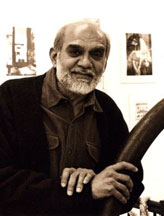
| Invitation |
| About the Exhibition |
| Curator |
| Venues |
| Sponsor Benefits |
| Photos |
| Panel Discussion & Closing Reception |
| Press Release |
| Art Events |
| Curator-led Tours & Artist Talk |
| Review |
| Buy Artwork |
| Call for Art |
| Erasing Borders: Passport to Contemporary Indian Art of the diaspora 2009 | ||
| Vijay Kumar | ||
|
||
Curators Note: So, at this time, we are especially pleased to be able to present work by these 28 artists from the Diaspora. The work in this show is a contemporary mix of painting, drawing and prints; photographs, C-prints, photomontage and video; sculpture and installation. Paintings and drawings by several artists explore the traditional fascination of perspective, geometry, shape, and color. Other artists mine the interior landscape of the mind--of imagination, experience, and memory. Alka Raghuram succinctly characterizes her recent series of paintings as exploring "relationships and the entanglement of needs and desires", while Nandini Chirimar describes her work as a "visual 'journal' of her life". The title of Asha Ganpat's photograph tells much: "The dogs stay warm where my grandmother burned" as does the fact that the artist chose to print this photograph on a blanket. The figures made from found objects by Indira Freitas Johnson, although whimsical, each have a strong presence. The installations by Pallavi Sharma, with camouflaged everyday shoes sitting on green plastic grass, have an unexpected poignancy. Haresh Lalvani's work is fabricated in stainless steel, very intricate and hi-tech. Quite a few of the artists-both abstract and figurative-describe their work (or the impetus behind it) in spiritual terms, and many of the works comment directly on environmental and political issues. Khalil Chishtee's figures are made out of plastic bags. Jagdish Prabhu has 'drawn' his figures in soot (carbon), the "much maligned but primal substance"…(whose)..."fluidity and etherealness embody the ephemeral nature of existence." Pritika Chowdhry's installation titled "What the Body Remembers" is comprised of sculptures that "investigate the potential of the… fragmented body to invoke collective narratives of trauma." Veru Narula's two oil paintings "The Digital Muse" and "The Islamic Chess Revolt" (with its whirling dervish figures) depict surreal landscapes whose imagery seems both timely and timeless. The poetic and haunting video installation by Prince Varughese Thomas titled "patriot ACTS 2-3-4" speaks "metaphorically about the dangers of blind patriotism". Like other pieces in this show its meaning remains ambiguous and multi-layered. Gautam Rao and Divya Mehra both use humor to explore underlying issues. In his video entitled "Restless Portrait: A Disappearing Painting" Gautam Rao paints, then continually re-paints a single self-portrait, his brush strokes in syncopation with the "frenetic" beats of the background music. Divya Mehra is "The Taxi Driver" in her video of that title; her energy and humor keep the viewer smiling. The photomontages by Neil Chowdhury call to mind chaotic Calcutta or Old Delhi's Chandni Chowk market scenes, but ones somehow off-kilter. The artist eloquently describes his "Waking from Dreams of India" as "a body of work that connects and contrasts my youthful fantasies of India with my adult experience building a relationship with the land of my ancestry. I hope to symbolize the merging of the actual lived journey with the expectations I carried for half a lifetime." The above are just some of the many remarkable artists in this exhibition. I want to thank All our hosting venues, Amina Ahmed for all of her help and patience, and also Aroon Shivdasani for her continuing strong support and enthusiasm for this annual exhibition. |
||
